Australian Taxation Law Analysis
VerifiedAdded on 2020/05/16
|16
|4406
|118
AI Summary
This assignment requires students to delve into various aspects of Australian taxation law. It focuses on analyzing the intricacies of capital gains tax, its impact, and the concept of negative gearing within the Australian housing market. Students are expected to examine relevant legal principles, draw upon prominent case studies, and critically evaluate the current tax regime in Australia.
Contribute Materials
Your contribution can guide someone’s learning journey. Share your
documents today.

Running head: TAXATION LAW
Taxation Law
Name of the Student
Name of the University
Authors Note
Course ID
Taxation Law
Name of the Student
Name of the University
Authors Note
Course ID
Secure Best Marks with AI Grader
Need help grading? Try our AI Grader for instant feedback on your assignments.
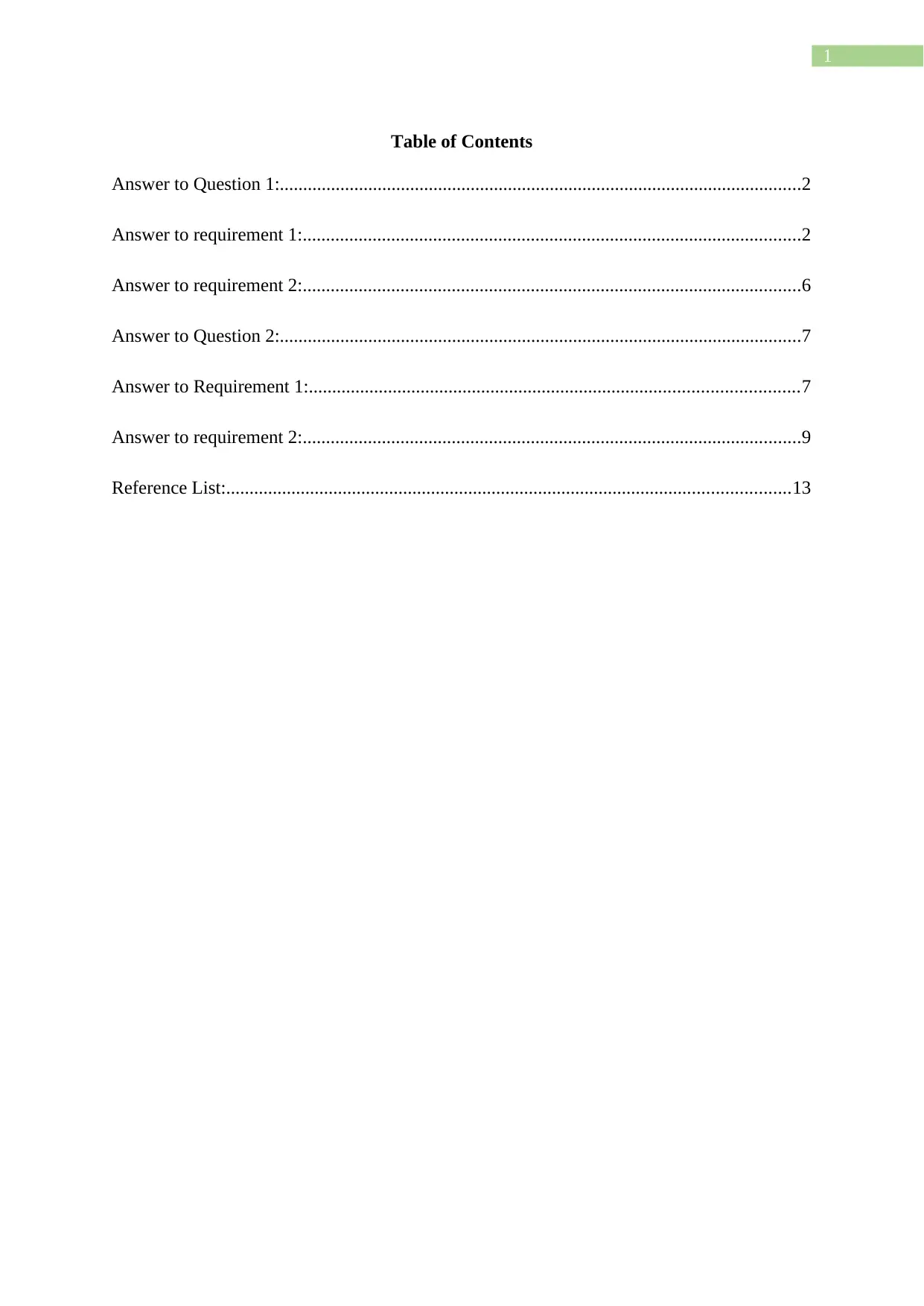
1
Table of Contents
Answer to Question 1:................................................................................................................2
Answer to requirement 1:...........................................................................................................2
Answer to requirement 2:...........................................................................................................6
Answer to Question 2:................................................................................................................7
Answer to Requirement 1:.........................................................................................................7
Answer to requirement 2:...........................................................................................................9
Reference List:.........................................................................................................................13
Table of Contents
Answer to Question 1:................................................................................................................2
Answer to requirement 1:...........................................................................................................2
Answer to requirement 2:...........................................................................................................6
Answer to Question 2:................................................................................................................7
Answer to Requirement 1:.........................................................................................................7
Answer to requirement 2:...........................................................................................................9
Reference List:.........................................................................................................................13

2
Answer to Question 1:
Answer to requirement 1:
The present case study is based on the ascertainemt of the residential status of Minh
relating to the income tax purpose. Additionally, the case study will be determining the
residential status effecting the assessment of income derived from Malaysian and the income
from investment in Australia.
The case study of Minh opens with the station the situation that the Minh was born in
Malaysia and carried out her business activities. In the later part of June 2016, she was
granted with the Visa of working in Australia and she arrived with her family with the
probable of intention of eventually migrating and starting a business. An instance was noticed
where Minh bought a home in Melbourne and resided with her partner and children with her
children being enrolled in the local school of Melbourne.
As the general jurisdictional rule stated under “section 6-5 (2), (6-10 (4) of the ITAA
1997” residents are generally assessed on based on the ordinary income and statutory income
derived from all the sources (Woellner et al. 2016). Accordingly as stated under “section 6-5
(3) (a) and 6-10 (5) (a) of the ITAA 1997” a foreign resident or non-resident of Australia are
assessed based on their ordinary and statutory income generated from the Australian sources.
According to the definition stated under the “section 995-1 of the ITAA 1997” and under
“section 6-(1) of the ITAA 1997” a resident or Australian resident for taxation purpose
represents an individual residing in Australia and comprises of the person that has the
domicile in Australia (Barkoczy 2016). An Australian resident represent a resident that has
been living in Australia either constantly or intermittently for more than half of the income
year unless the officer of taxation is content that the persons usual place of residence is out of
Australia and has no intent of taking up the residence in Australia (Vann 2016). In order to
Answer to Question 1:
Answer to requirement 1:
The present case study is based on the ascertainemt of the residential status of Minh
relating to the income tax purpose. Additionally, the case study will be determining the
residential status effecting the assessment of income derived from Malaysian and the income
from investment in Australia.
The case study of Minh opens with the station the situation that the Minh was born in
Malaysia and carried out her business activities. In the later part of June 2016, she was
granted with the Visa of working in Australia and she arrived with her family with the
probable of intention of eventually migrating and starting a business. An instance was noticed
where Minh bought a home in Melbourne and resided with her partner and children with her
children being enrolled in the local school of Melbourne.
As the general jurisdictional rule stated under “section 6-5 (2), (6-10 (4) of the ITAA
1997” residents are generally assessed on based on the ordinary income and statutory income
derived from all the sources (Woellner et al. 2016). Accordingly as stated under “section 6-5
(3) (a) and 6-10 (5) (a) of the ITAA 1997” a foreign resident or non-resident of Australia are
assessed based on their ordinary and statutory income generated from the Australian sources.
According to the definition stated under the “section 995-1 of the ITAA 1997” and under
“section 6-(1) of the ITAA 1997” a resident or Australian resident for taxation purpose
represents an individual residing in Australia and comprises of the person that has the
domicile in Australia (Barkoczy 2016). An Australian resident represent a resident that has
been living in Australia either constantly or intermittently for more than half of the income
year unless the officer of taxation is content that the persons usual place of residence is out of
Australia and has no intent of taking up the residence in Australia (Vann 2016). In order to
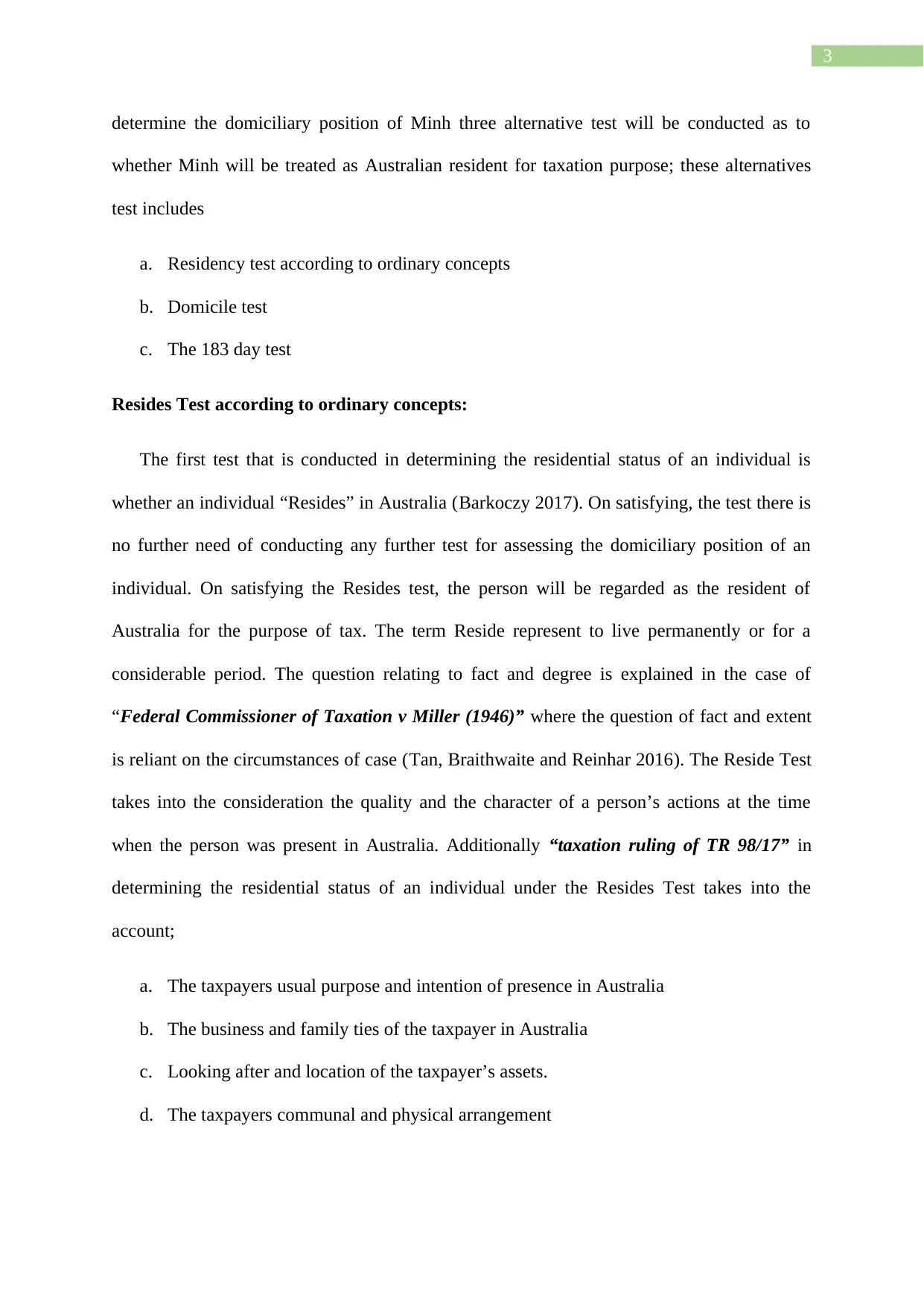
3
determine the domiciliary position of Minh three alternative test will be conducted as to
whether Minh will be treated as Australian resident for taxation purpose; these alternatives
test includes
a. Residency test according to ordinary concepts
b. Domicile test
c. The 183 day test
Resides Test according to ordinary concepts:
The first test that is conducted in determining the residential status of an individual is
whether an individual “Resides” in Australia (Barkoczy 2017). On satisfying, the test there is
no further need of conducting any further test for assessing the domiciliary position of an
individual. On satisfying the Resides test, the person will be regarded as the resident of
Australia for the purpose of tax. The term Reside represent to live permanently or for a
considerable period. The question relating to fact and degree is explained in the case of
“Federal Commissioner of Taxation v Miller (1946)” where the question of fact and extent
is reliant on the circumstances of case (Tan, Braithwaite and Reinhar 2016). The Reside Test
takes into the consideration the quality and the character of a person’s actions at the time
when the person was present in Australia. Additionally “taxation ruling of TR 98/17” in
determining the residential status of an individual under the Resides Test takes into the
account;
a. The taxpayers usual purpose and intention of presence in Australia
b. The business and family ties of the taxpayer in Australia
c. Looking after and location of the taxpayer’s assets.
d. The taxpayers communal and physical arrangement
determine the domiciliary position of Minh three alternative test will be conducted as to
whether Minh will be treated as Australian resident for taxation purpose; these alternatives
test includes
a. Residency test according to ordinary concepts
b. Domicile test
c. The 183 day test
Resides Test according to ordinary concepts:
The first test that is conducted in determining the residential status of an individual is
whether an individual “Resides” in Australia (Barkoczy 2017). On satisfying, the test there is
no further need of conducting any further test for assessing the domiciliary position of an
individual. On satisfying the Resides test, the person will be regarded as the resident of
Australia for the purpose of tax. The term Reside represent to live permanently or for a
considerable period. The question relating to fact and degree is explained in the case of
“Federal Commissioner of Taxation v Miller (1946)” where the question of fact and extent
is reliant on the circumstances of case (Tan, Braithwaite and Reinhar 2016). The Reside Test
takes into the consideration the quality and the character of a person’s actions at the time
when the person was present in Australia. Additionally “taxation ruling of TR 98/17” in
determining the residential status of an individual under the Resides Test takes into the
account;
a. The taxpayers usual purpose and intention of presence in Australia
b. The business and family ties of the taxpayer in Australia
c. Looking after and location of the taxpayer’s assets.
d. The taxpayers communal and physical arrangement
Secure Best Marks with AI Grader
Need help grading? Try our AI Grader for instant feedback on your assignments.
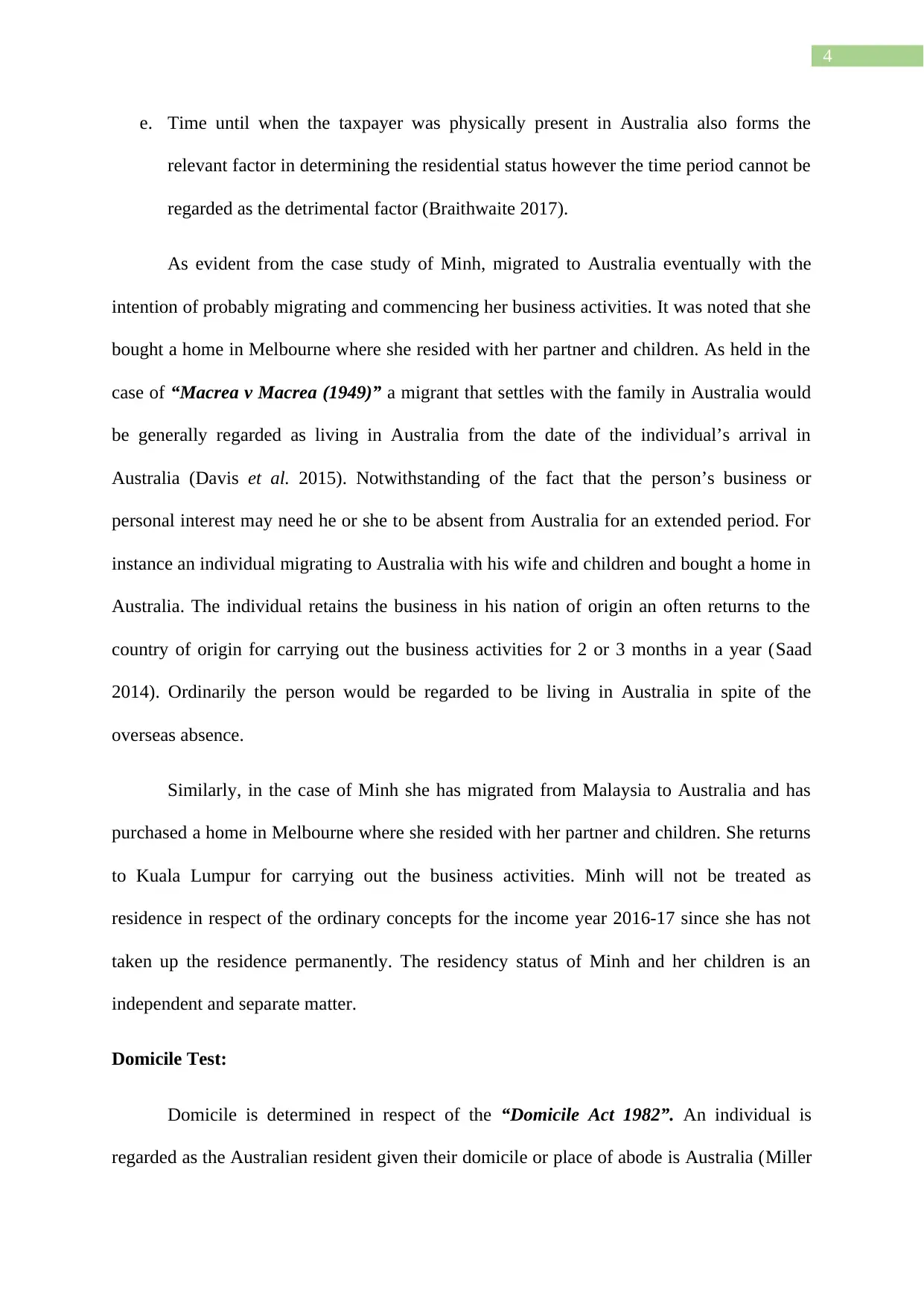
4
e. Time until when the taxpayer was physically present in Australia also forms the
relevant factor in determining the residential status however the time period cannot be
regarded as the detrimental factor (Braithwaite 2017).
As evident from the case study of Minh, migrated to Australia eventually with the
intention of probably migrating and commencing her business activities. It was noted that she
bought a home in Melbourne where she resided with her partner and children. As held in the
case of “Macrea v Macrea (1949)” a migrant that settles with the family in Australia would
be generally regarded as living in Australia from the date of the individual’s arrival in
Australia (Davis et al. 2015). Notwithstanding of the fact that the person’s business or
personal interest may need he or she to be absent from Australia for an extended period. For
instance an individual migrating to Australia with his wife and children and bought a home in
Australia. The individual retains the business in his nation of origin an often returns to the
country of origin for carrying out the business activities for 2 or 3 months in a year (Saad
2014). Ordinarily the person would be regarded to be living in Australia in spite of the
overseas absence.
Similarly, in the case of Minh she has migrated from Malaysia to Australia and has
purchased a home in Melbourne where she resided with her partner and children. She returns
to Kuala Lumpur for carrying out the business activities. Minh will not be treated as
residence in respect of the ordinary concepts for the income year 2016-17 since she has not
taken up the residence permanently. The residency status of Minh and her children is an
independent and separate matter.
Domicile Test:
Domicile is determined in respect of the “Domicile Act 1982”. An individual is
regarded as the Australian resident given their domicile or place of abode is Australia (Miller
e. Time until when the taxpayer was physically present in Australia also forms the
relevant factor in determining the residential status however the time period cannot be
regarded as the detrimental factor (Braithwaite 2017).
As evident from the case study of Minh, migrated to Australia eventually with the
intention of probably migrating and commencing her business activities. It was noted that she
bought a home in Melbourne where she resided with her partner and children. As held in the
case of “Macrea v Macrea (1949)” a migrant that settles with the family in Australia would
be generally regarded as living in Australia from the date of the individual’s arrival in
Australia (Davis et al. 2015). Notwithstanding of the fact that the person’s business or
personal interest may need he or she to be absent from Australia for an extended period. For
instance an individual migrating to Australia with his wife and children and bought a home in
Australia. The individual retains the business in his nation of origin an often returns to the
country of origin for carrying out the business activities for 2 or 3 months in a year (Saad
2014). Ordinarily the person would be regarded to be living in Australia in spite of the
overseas absence.
Similarly, in the case of Minh she has migrated from Malaysia to Australia and has
purchased a home in Melbourne where she resided with her partner and children. She returns
to Kuala Lumpur for carrying out the business activities. Minh will not be treated as
residence in respect of the ordinary concepts for the income year 2016-17 since she has not
taken up the residence permanently. The residency status of Minh and her children is an
independent and separate matter.
Domicile Test:
Domicile is determined in respect of the “Domicile Act 1982”. An individual is
regarded as the Australian resident given their domicile or place of abode is Australia (Miller
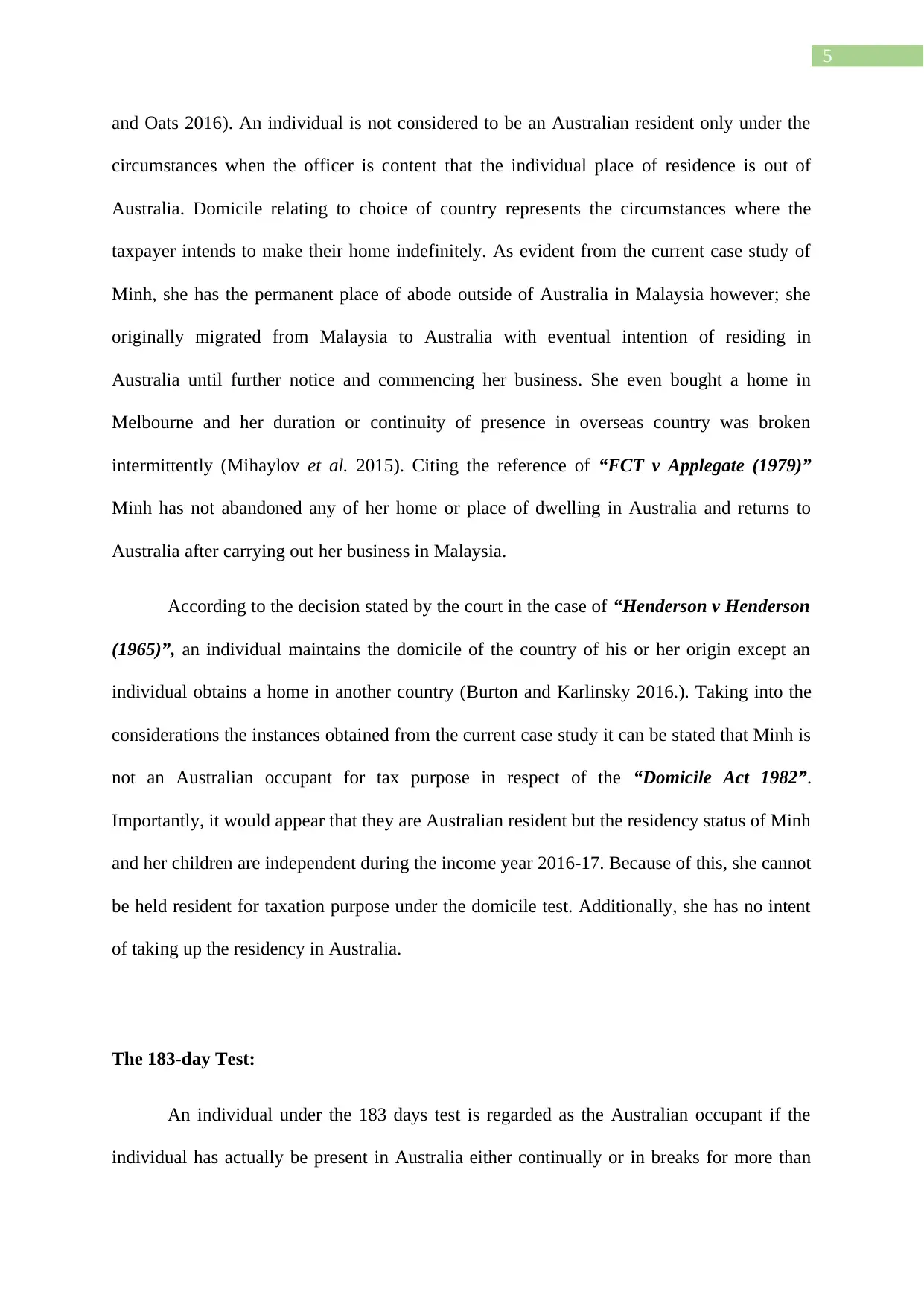
5
and Oats 2016). An individual is not considered to be an Australian resident only under the
circumstances when the officer is content that the individual place of residence is out of
Australia. Domicile relating to choice of country represents the circumstances where the
taxpayer intends to make their home indefinitely. As evident from the current case study of
Minh, she has the permanent place of abode outside of Australia in Malaysia however; she
originally migrated from Malaysia to Australia with eventual intention of residing in
Australia until further notice and commencing her business. She even bought a home in
Melbourne and her duration or continuity of presence in overseas country was broken
intermittently (Mihaylov et al. 2015). Citing the reference of “FCT v Applegate (1979)”
Minh has not abandoned any of her home or place of dwelling in Australia and returns to
Australia after carrying out her business in Malaysia.
According to the decision stated by the court in the case of “Henderson v Henderson
(1965)”, an individual maintains the domicile of the country of his or her origin except an
individual obtains a home in another country (Burton and Karlinsky 2016.). Taking into the
considerations the instances obtained from the current case study it can be stated that Minh is
not an Australian occupant for tax purpose in respect of the “Domicile Act 1982”.
Importantly, it would appear that they are Australian resident but the residency status of Minh
and her children are independent during the income year 2016-17. Because of this, she cannot
be held resident for taxation purpose under the domicile test. Additionally, she has no intent
of taking up the residency in Australia.
The 183-day Test:
An individual under the 183 days test is regarded as the Australian occupant if the
individual has actually be present in Australia either continually or in breaks for more than
and Oats 2016). An individual is not considered to be an Australian resident only under the
circumstances when the officer is content that the individual place of residence is out of
Australia. Domicile relating to choice of country represents the circumstances where the
taxpayer intends to make their home indefinitely. As evident from the current case study of
Minh, she has the permanent place of abode outside of Australia in Malaysia however; she
originally migrated from Malaysia to Australia with eventual intention of residing in
Australia until further notice and commencing her business. She even bought a home in
Melbourne and her duration or continuity of presence in overseas country was broken
intermittently (Mihaylov et al. 2015). Citing the reference of “FCT v Applegate (1979)”
Minh has not abandoned any of her home or place of dwelling in Australia and returns to
Australia after carrying out her business in Malaysia.
According to the decision stated by the court in the case of “Henderson v Henderson
(1965)”, an individual maintains the domicile of the country of his or her origin except an
individual obtains a home in another country (Burton and Karlinsky 2016.). Taking into the
considerations the instances obtained from the current case study it can be stated that Minh is
not an Australian occupant for tax purpose in respect of the “Domicile Act 1982”.
Importantly, it would appear that they are Australian resident but the residency status of Minh
and her children are independent during the income year 2016-17. Because of this, she cannot
be held resident for taxation purpose under the domicile test. Additionally, she has no intent
of taking up the residency in Australia.
The 183-day Test:
An individual under the 183 days test is regarded as the Australian occupant if the
individual has actually be present in Australia either continually or in breaks for more than

6
one half of the income year (Davison, Monotti and Wiseman 2015). An exception to this rule
is that a person will not be considered as the Australian resident if the individual satisfies the
commissioner of taxation that if, his normal place of dwelling is out of Australia and has no
purpose of taking up the residency of Australia. The 183 days test is helpful in determining
whether an individual has commenced living in Australia.
As evident from the current situation of Minh, it is noticed that she has only spend
120 days in Australia. An individual is regarded as the Australian resident given the person
has successfully met the criteria of 183 days and meets the definition of the resident in
respect to the “subsection 6 (1) of the ITAA 1997”. However, an important assertion can be
bought forward by stating that a person under the 183 days test is only regarded to hold as
resident if an individual has been present and living in Australia for more than six months of
the year of income (Grudnoff 2015). Minh in this aspect has not been presented in Australia
for more one half of the income and as result of this for the year 2016-17 she cannot be
regarded as resident of Australia for the purpose of tax.
On a conclusive note, an assertion can be bought forward by stating that Minh
residency will be considered as separate and independent matter. She cannot be considered as
Australian resident for taxation purpose since she has not met the criteria of Resident in terms
of the ordinary concept, domicile test and 183 days test. More importantly the residency
status of Minh is independent and distinct subject.
Answer to requirement 2:
According to the judgement stated in the case of “Nathan v FCT (1918)” in
determining the original source of income is regarded as practical and hard matter of fact
(Evans, Minas and Lim 2015). Referring to the judgement of federal court in “United
one half of the income year (Davison, Monotti and Wiseman 2015). An exception to this rule
is that a person will not be considered as the Australian resident if the individual satisfies the
commissioner of taxation that if, his normal place of dwelling is out of Australia and has no
purpose of taking up the residency of Australia. The 183 days test is helpful in determining
whether an individual has commenced living in Australia.
As evident from the current situation of Minh, it is noticed that she has only spend
120 days in Australia. An individual is regarded as the Australian resident given the person
has successfully met the criteria of 183 days and meets the definition of the resident in
respect to the “subsection 6 (1) of the ITAA 1997”. However, an important assertion can be
bought forward by stating that a person under the 183 days test is only regarded to hold as
resident if an individual has been present and living in Australia for more than six months of
the year of income (Grudnoff 2015). Minh in this aspect has not been presented in Australia
for more one half of the income and as result of this for the year 2016-17 she cannot be
regarded as resident of Australia for the purpose of tax.
On a conclusive note, an assertion can be bought forward by stating that Minh
residency will be considered as separate and independent matter. She cannot be considered as
Australian resident for taxation purpose since she has not met the criteria of Resident in terms
of the ordinary concept, domicile test and 183 days test. More importantly the residency
status of Minh is independent and distinct subject.
Answer to requirement 2:
According to the judgement stated in the case of “Nathan v FCT (1918)” in
determining the original source of income is regarded as practical and hard matter of fact
(Evans, Minas and Lim 2015). Referring to the judgement of federal court in “United
Paraphrase This Document
Need a fresh take? Get an instant paraphrase of this document with our AI Paraphraser
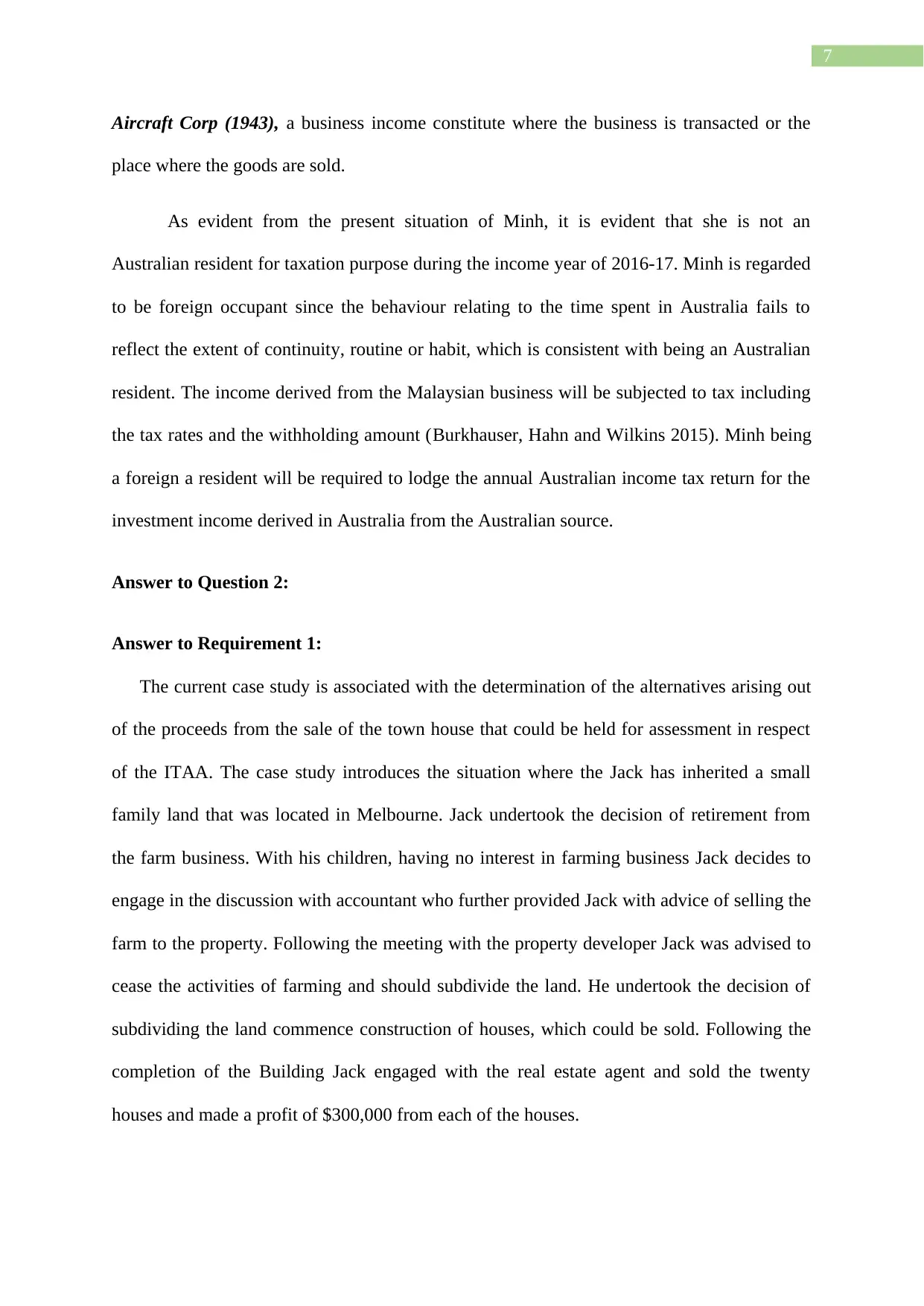
7
Aircraft Corp (1943), a business income constitute where the business is transacted or the
place where the goods are sold.
As evident from the present situation of Minh, it is evident that she is not an
Australian resident for taxation purpose during the income year of 2016-17. Minh is regarded
to be foreign occupant since the behaviour relating to the time spent in Australia fails to
reflect the extent of continuity, routine or habit, which is consistent with being an Australian
resident. The income derived from the Malaysian business will be subjected to tax including
the tax rates and the withholding amount (Burkhauser, Hahn and Wilkins 2015). Minh being
a foreign a resident will be required to lodge the annual Australian income tax return for the
investment income derived in Australia from the Australian source.
Answer to Question 2:
Answer to Requirement 1:
The current case study is associated with the determination of the alternatives arising out
of the proceeds from the sale of the town house that could be held for assessment in respect
of the ITAA. The case study introduces the situation where the Jack has inherited a small
family land that was located in Melbourne. Jack undertook the decision of retirement from
the farm business. With his children, having no interest in farming business Jack decides to
engage in the discussion with accountant who further provided Jack with advice of selling the
farm to the property. Following the meeting with the property developer Jack was advised to
cease the activities of farming and should subdivide the land. He undertook the decision of
subdividing the land commence construction of houses, which could be sold. Following the
completion of the Building Jack engaged with the real estate agent and sold the twenty
houses and made a profit of $300,000 from each of the houses.
Aircraft Corp (1943), a business income constitute where the business is transacted or the
place where the goods are sold.
As evident from the present situation of Minh, it is evident that she is not an
Australian resident for taxation purpose during the income year of 2016-17. Minh is regarded
to be foreign occupant since the behaviour relating to the time spent in Australia fails to
reflect the extent of continuity, routine or habit, which is consistent with being an Australian
resident. The income derived from the Malaysian business will be subjected to tax including
the tax rates and the withholding amount (Burkhauser, Hahn and Wilkins 2015). Minh being
a foreign a resident will be required to lodge the annual Australian income tax return for the
investment income derived in Australia from the Australian source.
Answer to Question 2:
Answer to Requirement 1:
The current case study is associated with the determination of the alternatives arising out
of the proceeds from the sale of the town house that could be held for assessment in respect
of the ITAA. The case study introduces the situation where the Jack has inherited a small
family land that was located in Melbourne. Jack undertook the decision of retirement from
the farm business. With his children, having no interest in farming business Jack decides to
engage in the discussion with accountant who further provided Jack with advice of selling the
farm to the property. Following the meeting with the property developer Jack was advised to
cease the activities of farming and should subdivide the land. He undertook the decision of
subdividing the land commence construction of houses, which could be sold. Following the
completion of the Building Jack engaged with the real estate agent and sold the twenty
houses and made a profit of $300,000 from each of the houses.
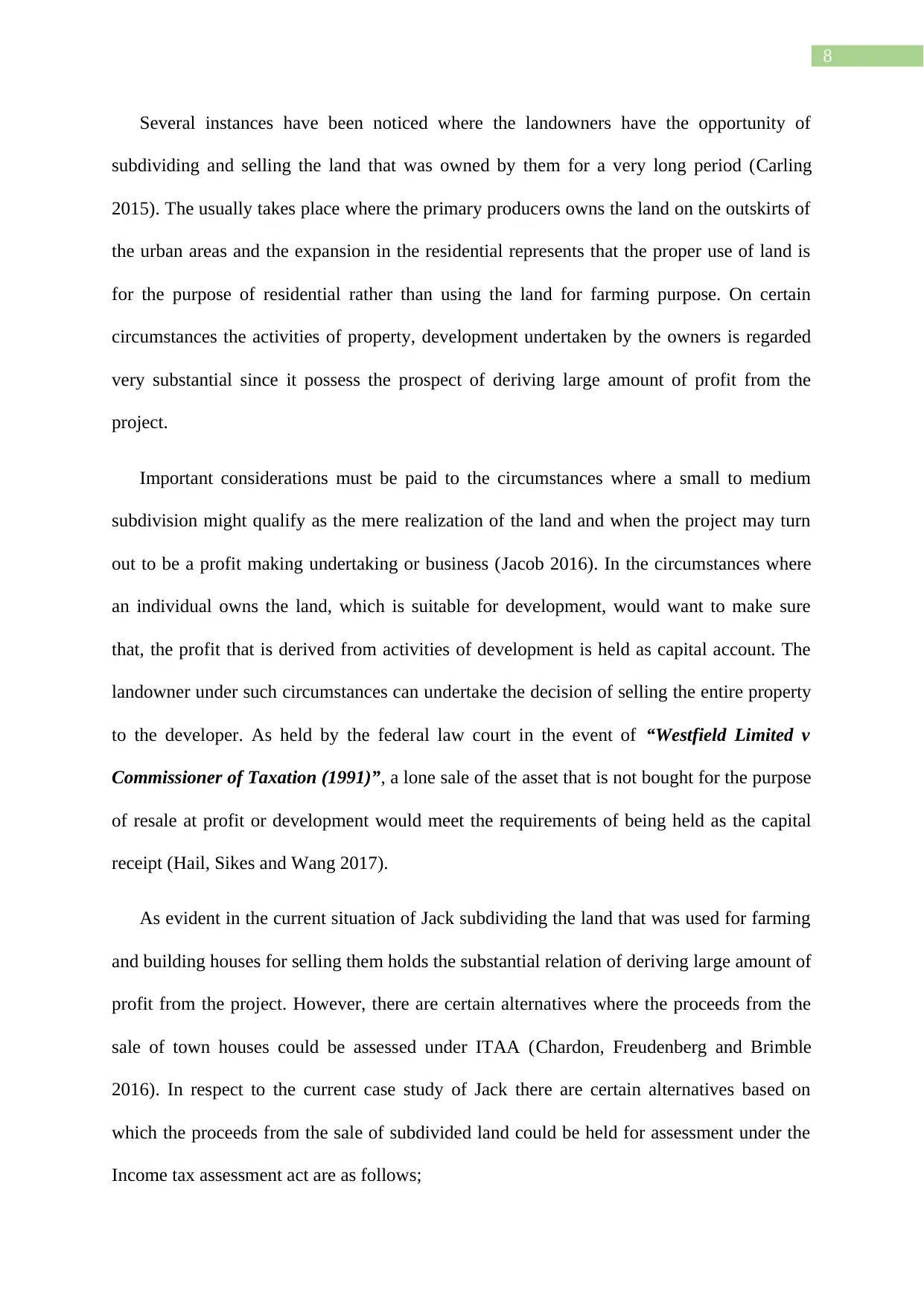
8
Several instances have been noticed where the landowners have the opportunity of
subdividing and selling the land that was owned by them for a very long period (Carling
2015). The usually takes place where the primary producers owns the land on the outskirts of
the urban areas and the expansion in the residential represents that the proper use of land is
for the purpose of residential rather than using the land for farming purpose. On certain
circumstances the activities of property, development undertaken by the owners is regarded
very substantial since it possess the prospect of deriving large amount of profit from the
project.
Important considerations must be paid to the circumstances where a small to medium
subdivision might qualify as the mere realization of the land and when the project may turn
out to be a profit making undertaking or business (Jacob 2016). In the circumstances where
an individual owns the land, which is suitable for development, would want to make sure
that, the profit that is derived from activities of development is held as capital account. The
landowner under such circumstances can undertake the decision of selling the entire property
to the developer. As held by the federal law court in the event of “Westfield Limited v
Commissioner of Taxation (1991)”, a lone sale of the asset that is not bought for the purpose
of resale at profit or development would meet the requirements of being held as the capital
receipt (Hail, Sikes and Wang 2017).
As evident in the current situation of Jack subdividing the land that was used for farming
and building houses for selling them holds the substantial relation of deriving large amount of
profit from the project. However, there are certain alternatives where the proceeds from the
sale of town houses could be assessed under ITAA (Chardon, Freudenberg and Brimble
2016). In respect to the current case study of Jack there are certain alternatives based on
which the proceeds from the sale of subdivided land could be held for assessment under the
Income tax assessment act are as follows;
Several instances have been noticed where the landowners have the opportunity of
subdividing and selling the land that was owned by them for a very long period (Carling
2015). The usually takes place where the primary producers owns the land on the outskirts of
the urban areas and the expansion in the residential represents that the proper use of land is
for the purpose of residential rather than using the land for farming purpose. On certain
circumstances the activities of property, development undertaken by the owners is regarded
very substantial since it possess the prospect of deriving large amount of profit from the
project.
Important considerations must be paid to the circumstances where a small to medium
subdivision might qualify as the mere realization of the land and when the project may turn
out to be a profit making undertaking or business (Jacob 2016). In the circumstances where
an individual owns the land, which is suitable for development, would want to make sure
that, the profit that is derived from activities of development is held as capital account. The
landowner under such circumstances can undertake the decision of selling the entire property
to the developer. As held by the federal law court in the event of “Westfield Limited v
Commissioner of Taxation (1991)”, a lone sale of the asset that is not bought for the purpose
of resale at profit or development would meet the requirements of being held as the capital
receipt (Hail, Sikes and Wang 2017).
As evident in the current situation of Jack subdividing the land that was used for farming
and building houses for selling them holds the substantial relation of deriving large amount of
profit from the project. However, there are certain alternatives where the proceeds from the
sale of town houses could be assessed under ITAA (Chardon, Freudenberg and Brimble
2016). In respect to the current case study of Jack there are certain alternatives based on
which the proceeds from the sale of subdivided land could be held for assessment under the
Income tax assessment act are as follows;

9
a. The subdivision and the sale of land might qualify as the mere realization of the
capital asset.
b. The scale of business might be in such manner that it may constitute carrying on of a
business of property development by the taxpayer (Tax 2015).
c. The development might go beyond the concept of mere realization of land but may
shortfall of the requirements of carrying on of a business. In such a situation, it would
be characterised as the profit making undertaking or scheme.
Answer to requirement 2:
As evident from the current case study of Jack, the three alternatives has been
demonstrated above that could be put into use to determine the assessment of the sale of town
house by Jack under the provision of ITAA. In context to the alternatives mere realization of
capital asset is applicable on Jack since the property was subdivided and sold by the Jack in
20 lots.
The judgement of federal court in “Allied Pastoral Holdings v FC of T (1983)” has
defined the circumstances of mere realisation of asset (Coleman and Sadiq 2013). Several
authorities have affirmed that the taxpayer having land constitute a capital asset and
development of land in an enterprising manner could consider the profit derived from land as
the mere realization of the capital asset given the development is not more than the mere
realization of the capital asset.
Prior to embarking on the detailed analysis of present situation of Jack in establishing
that the building of house on farm land is a mere realisation it is necessary to determine
whether Jack has acquired the farm land for the purpose of resale at profit or development
(Kenny 2013). Therefore, the income generated from the sale of land would be held
assessable as ordinary income notwithstanding of the sale of property. Therefore at the time
a. The subdivision and the sale of land might qualify as the mere realization of the
capital asset.
b. The scale of business might be in such manner that it may constitute carrying on of a
business of property development by the taxpayer (Tax 2015).
c. The development might go beyond the concept of mere realization of land but may
shortfall of the requirements of carrying on of a business. In such a situation, it would
be characterised as the profit making undertaking or scheme.
Answer to requirement 2:
As evident from the current case study of Jack, the three alternatives has been
demonstrated above that could be put into use to determine the assessment of the sale of town
house by Jack under the provision of ITAA. In context to the alternatives mere realization of
capital asset is applicable on Jack since the property was subdivided and sold by the Jack in
20 lots.
The judgement of federal court in “Allied Pastoral Holdings v FC of T (1983)” has
defined the circumstances of mere realisation of asset (Coleman and Sadiq 2013). Several
authorities have affirmed that the taxpayer having land constitute a capital asset and
development of land in an enterprising manner could consider the profit derived from land as
the mere realization of the capital asset given the development is not more than the mere
realization of the capital asset.
Prior to embarking on the detailed analysis of present situation of Jack in establishing
that the building of house on farm land is a mere realisation it is necessary to determine
whether Jack has acquired the farm land for the purpose of resale at profit or development
(Kenny 2013). Therefore, the income generated from the sale of land would be held
assessable as ordinary income notwithstanding of the sale of property. Therefore at the time
Secure Best Marks with AI Grader
Need help grading? Try our AI Grader for instant feedback on your assignments.
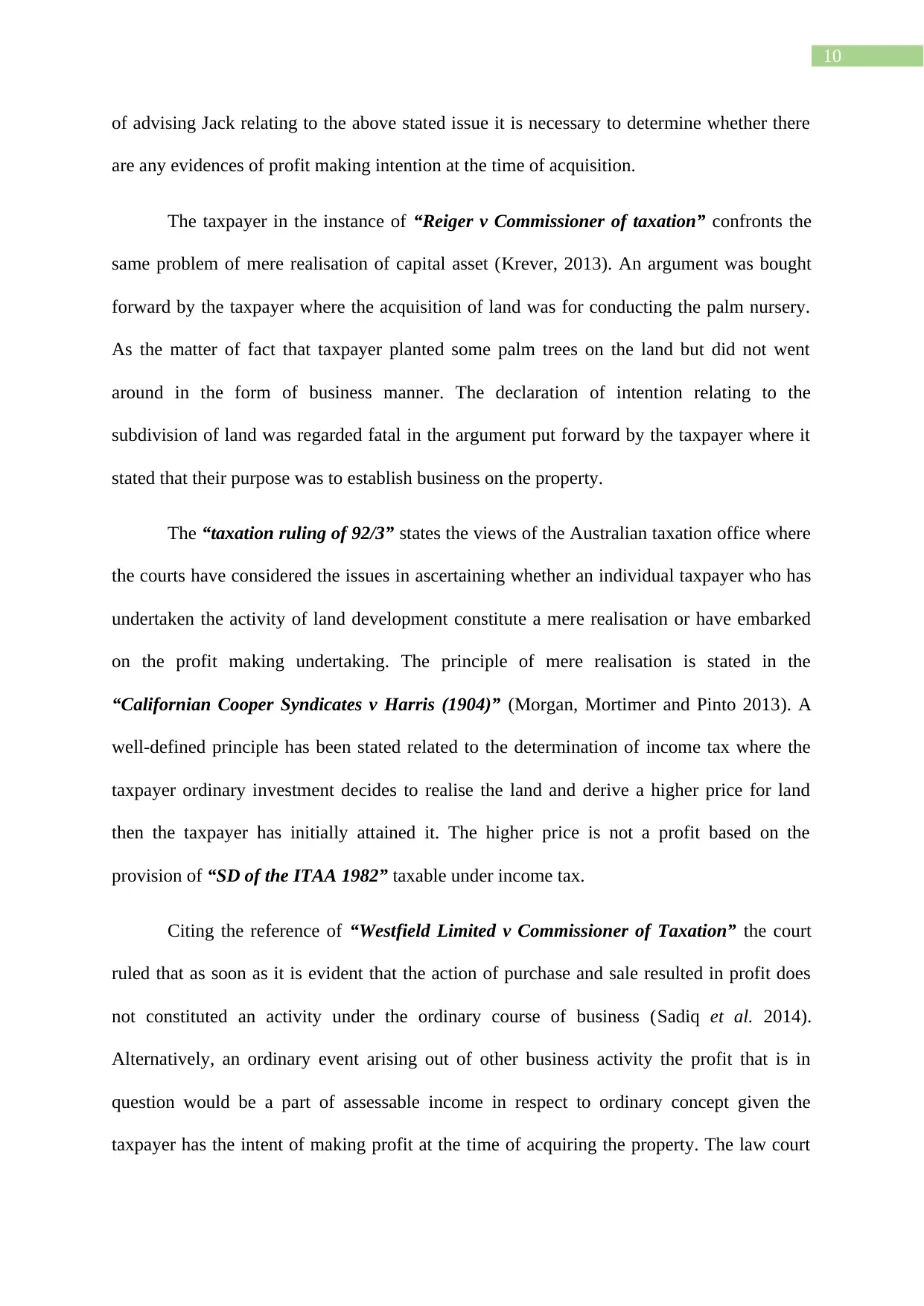
10
of advising Jack relating to the above stated issue it is necessary to determine whether there
are any evidences of profit making intention at the time of acquisition.
The taxpayer in the instance of “Reiger v Commissioner of taxation” confronts the
same problem of mere realisation of capital asset (Krever, 2013). An argument was bought
forward by the taxpayer where the acquisition of land was for conducting the palm nursery.
As the matter of fact that taxpayer planted some palm trees on the land but did not went
around in the form of business manner. The declaration of intention relating to the
subdivision of land was regarded fatal in the argument put forward by the taxpayer where it
stated that their purpose was to establish business on the property.
The “taxation ruling of 92/3” states the views of the Australian taxation office where
the courts have considered the issues in ascertaining whether an individual taxpayer who has
undertaken the activity of land development constitute a mere realisation or have embarked
on the profit making undertaking. The principle of mere realisation is stated in the
“Californian Cooper Syndicates v Harris (1904)” (Morgan, Mortimer and Pinto 2013). A
well-defined principle has been stated related to the determination of income tax where the
taxpayer ordinary investment decides to realise the land and derive a higher price for land
then the taxpayer has initially attained it. The higher price is not a profit based on the
provision of “SD of the ITAA 1982” taxable under income tax.
Citing the reference of “Westfield Limited v Commissioner of Taxation” the court
ruled that as soon as it is evident that the action of purchase and sale resulted in profit does
not constituted an activity under the ordinary course of business (Sadiq et al. 2014).
Alternatively, an ordinary event arising out of other business activity the profit that is in
question would be a part of assessable income in respect to ordinary concept given the
taxpayer has the intent of making profit at the time of acquiring the property. The law court
of advising Jack relating to the above stated issue it is necessary to determine whether there
are any evidences of profit making intention at the time of acquisition.
The taxpayer in the instance of “Reiger v Commissioner of taxation” confronts the
same problem of mere realisation of capital asset (Krever, 2013). An argument was bought
forward by the taxpayer where the acquisition of land was for conducting the palm nursery.
As the matter of fact that taxpayer planted some palm trees on the land but did not went
around in the form of business manner. The declaration of intention relating to the
subdivision of land was regarded fatal in the argument put forward by the taxpayer where it
stated that their purpose was to establish business on the property.
The “taxation ruling of 92/3” states the views of the Australian taxation office where
the courts have considered the issues in ascertaining whether an individual taxpayer who has
undertaken the activity of land development constitute a mere realisation or have embarked
on the profit making undertaking. The principle of mere realisation is stated in the
“Californian Cooper Syndicates v Harris (1904)” (Morgan, Mortimer and Pinto 2013). A
well-defined principle has been stated related to the determination of income tax where the
taxpayer ordinary investment decides to realise the land and derive a higher price for land
then the taxpayer has initially attained it. The higher price is not a profit based on the
provision of “SD of the ITAA 1982” taxable under income tax.
Citing the reference of “Westfield Limited v Commissioner of Taxation” the court
ruled that as soon as it is evident that the action of purchase and sale resulted in profit does
not constituted an activity under the ordinary course of business (Sadiq et al. 2014).
Alternatively, an ordinary event arising out of other business activity the profit that is in
question would be a part of assessable income in respect to ordinary concept given the
taxpayer has the intent of making profit at the time of acquiring the property. The law court
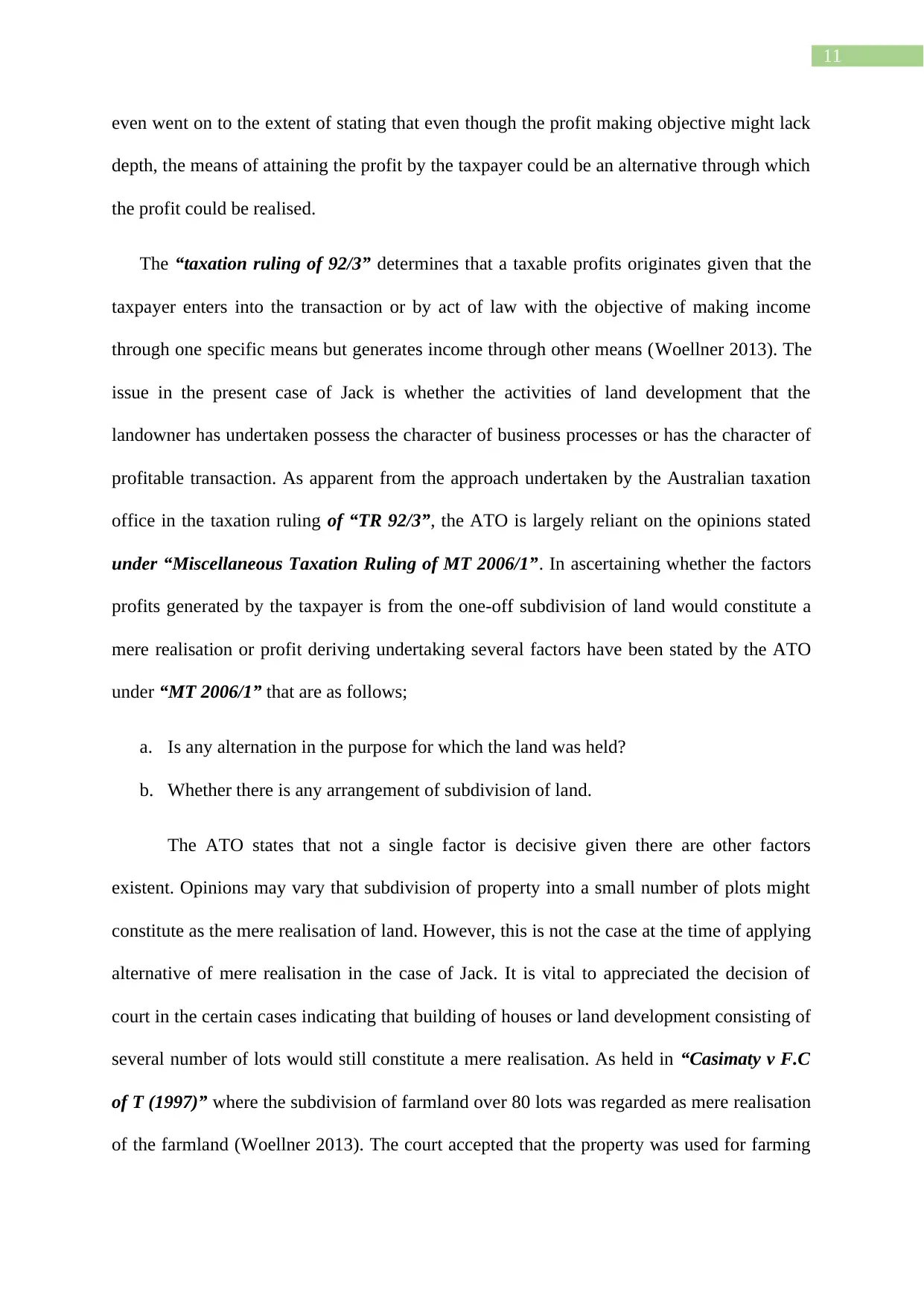
11
even went on to the extent of stating that even though the profit making objective might lack
depth, the means of attaining the profit by the taxpayer could be an alternative through which
the profit could be realised.
The “taxation ruling of 92/3” determines that a taxable profits originates given that the
taxpayer enters into the transaction or by act of law with the objective of making income
through one specific means but generates income through other means (Woellner 2013). The
issue in the present case of Jack is whether the activities of land development that the
landowner has undertaken possess the character of business processes or has the character of
profitable transaction. As apparent from the approach undertaken by the Australian taxation
office in the taxation ruling of “TR 92/3”, the ATO is largely reliant on the opinions stated
under “Miscellaneous Taxation Ruling of MT 2006/1”. In ascertaining whether the factors
profits generated by the taxpayer is from the one-off subdivision of land would constitute a
mere realisation or profit deriving undertaking several factors have been stated by the ATO
under “MT 2006/1” that are as follows;
a. Is any alternation in the purpose for which the land was held?
b. Whether there is any arrangement of subdivision of land.
The ATO states that not a single factor is decisive given there are other factors
existent. Opinions may vary that subdivision of property into a small number of plots might
constitute as the mere realisation of land. However, this is not the case at the time of applying
alternative of mere realisation in the case of Jack. It is vital to appreciated the decision of
court in the certain cases indicating that building of houses or land development consisting of
several number of lots would still constitute a mere realisation. As held in “Casimaty v F.C
of T (1997)” where the subdivision of farmland over 80 lots was regarded as mere realisation
of the farmland (Woellner 2013). The court accepted that the property was used for farming
even went on to the extent of stating that even though the profit making objective might lack
depth, the means of attaining the profit by the taxpayer could be an alternative through which
the profit could be realised.
The “taxation ruling of 92/3” determines that a taxable profits originates given that the
taxpayer enters into the transaction or by act of law with the objective of making income
through one specific means but generates income through other means (Woellner 2013). The
issue in the present case of Jack is whether the activities of land development that the
landowner has undertaken possess the character of business processes or has the character of
profitable transaction. As apparent from the approach undertaken by the Australian taxation
office in the taxation ruling of “TR 92/3”, the ATO is largely reliant on the opinions stated
under “Miscellaneous Taxation Ruling of MT 2006/1”. In ascertaining whether the factors
profits generated by the taxpayer is from the one-off subdivision of land would constitute a
mere realisation or profit deriving undertaking several factors have been stated by the ATO
under “MT 2006/1” that are as follows;
a. Is any alternation in the purpose for which the land was held?
b. Whether there is any arrangement of subdivision of land.
The ATO states that not a single factor is decisive given there are other factors
existent. Opinions may vary that subdivision of property into a small number of plots might
constitute as the mere realisation of land. However, this is not the case at the time of applying
alternative of mere realisation in the case of Jack. It is vital to appreciated the decision of
court in the certain cases indicating that building of houses or land development consisting of
several number of lots would still constitute a mere realisation. As held in “Casimaty v F.C
of T (1997)” where the subdivision of farmland over 80 lots was regarded as mere realisation
of the farmland (Woellner 2013). The court accepted that the property was used for farming

12
for several years and the decision of subdivision was entirely because of the increasing debt
and poor health of the taxpayer.
Citing the example of “McCorkell v F.C of T” the court stated its verdict that
subdivision of land that was earlier used as orchard would constitute a mere realisation of the
property. Considerably the case of “Statham v F.C of T (1989)” a development of 105 lots
beyond four stages was held nothing less than a mere realisation of the capital asset (Sadiq et
al. 2014). In the current case of Jack, the land acquired by him and sold after a longer time it
is very likely the subdivision and sale of twenty townhouse would be categorised as the mere
realisation. The proceeds that are derived by Jack will be based on the capital account and not
on the revenue account.
for several years and the decision of subdivision was entirely because of the increasing debt
and poor health of the taxpayer.
Citing the example of “McCorkell v F.C of T” the court stated its verdict that
subdivision of land that was earlier used as orchard would constitute a mere realisation of the
property. Considerably the case of “Statham v F.C of T (1989)” a development of 105 lots
beyond four stages was held nothing less than a mere realisation of the capital asset (Sadiq et
al. 2014). In the current case of Jack, the land acquired by him and sold after a longer time it
is very likely the subdivision and sale of twenty townhouse would be categorised as the mere
realisation. The proceeds that are derived by Jack will be based on the capital account and not
on the revenue account.
Paraphrase This Document
Need a fresh take? Get an instant paraphrase of this document with our AI Paraphraser

13
Reference List:
Barkoczy, S., 2016. Foundations of taxation law 2016. OUP Catalogue.
Barkoczy, S., 2017. Core tax legislation and study guide. OUP Catalogue.
Braithwaite, V. ed., 2017. Taxing democracy: Understanding tax avoidance and evasion.
Routledge.
Burkhauser, R.V., Hahn, M.H. and Wilkins, R., 2015. Measuring top incomes using tax
record data: A cautionary tale from Australia. The Journal of Economic Inequality, 13(2),
pp.181-205.
Burton, H.A. and Karlinsky, S., 2016. Tax professionals' perception of large and mid-size
business US tax law complexity. eJournal of Tax Research, 14(1), p.61.
Carling, R.G., 2015. Right or rort? Dissecting Australia's tax concessions. Centre for
Independent Studies.
Chardon, T., Freudenberg, B. and Brimble, M., 2016. Tax literacy in Australia: not knowing
your deduction from your offset. Austl. Tax F., 31, p.321.
Coleman, C. and Sadiq, K. (n.d.). Principles of taxation law 2013.
Davis, A.K., Guenther, D.A., Krull, L.K. and Williams, B.M., 2015. Do socially responsible
firms pay more taxes?. The accounting review, 91(1), pp.47-68.
Davison, M., Monotti, A. and Wiseman, L., 2015. Australian intellectual property law.
Cambridge University Press.
Evans, C., Minas, J. and Lim, Y., 2015. Taxing personal capital gains in Australia: an
alternative way forward. Austl. Tax F., 30, p.735.
Reference List:
Barkoczy, S., 2016. Foundations of taxation law 2016. OUP Catalogue.
Barkoczy, S., 2017. Core tax legislation and study guide. OUP Catalogue.
Braithwaite, V. ed., 2017. Taxing democracy: Understanding tax avoidance and evasion.
Routledge.
Burkhauser, R.V., Hahn, M.H. and Wilkins, R., 2015. Measuring top incomes using tax
record data: A cautionary tale from Australia. The Journal of Economic Inequality, 13(2),
pp.181-205.
Burton, H.A. and Karlinsky, S., 2016. Tax professionals' perception of large and mid-size
business US tax law complexity. eJournal of Tax Research, 14(1), p.61.
Carling, R.G., 2015. Right or rort? Dissecting Australia's tax concessions. Centre for
Independent Studies.
Chardon, T., Freudenberg, B. and Brimble, M., 2016. Tax literacy in Australia: not knowing
your deduction from your offset. Austl. Tax F., 31, p.321.
Coleman, C. and Sadiq, K. (n.d.). Principles of taxation law 2013.
Davis, A.K., Guenther, D.A., Krull, L.K. and Williams, B.M., 2015. Do socially responsible
firms pay more taxes?. The accounting review, 91(1), pp.47-68.
Davison, M., Monotti, A. and Wiseman, L., 2015. Australian intellectual property law.
Cambridge University Press.
Evans, C., Minas, J. and Lim, Y., 2015. Taxing personal capital gains in Australia: an
alternative way forward. Austl. Tax F., 30, p.735.
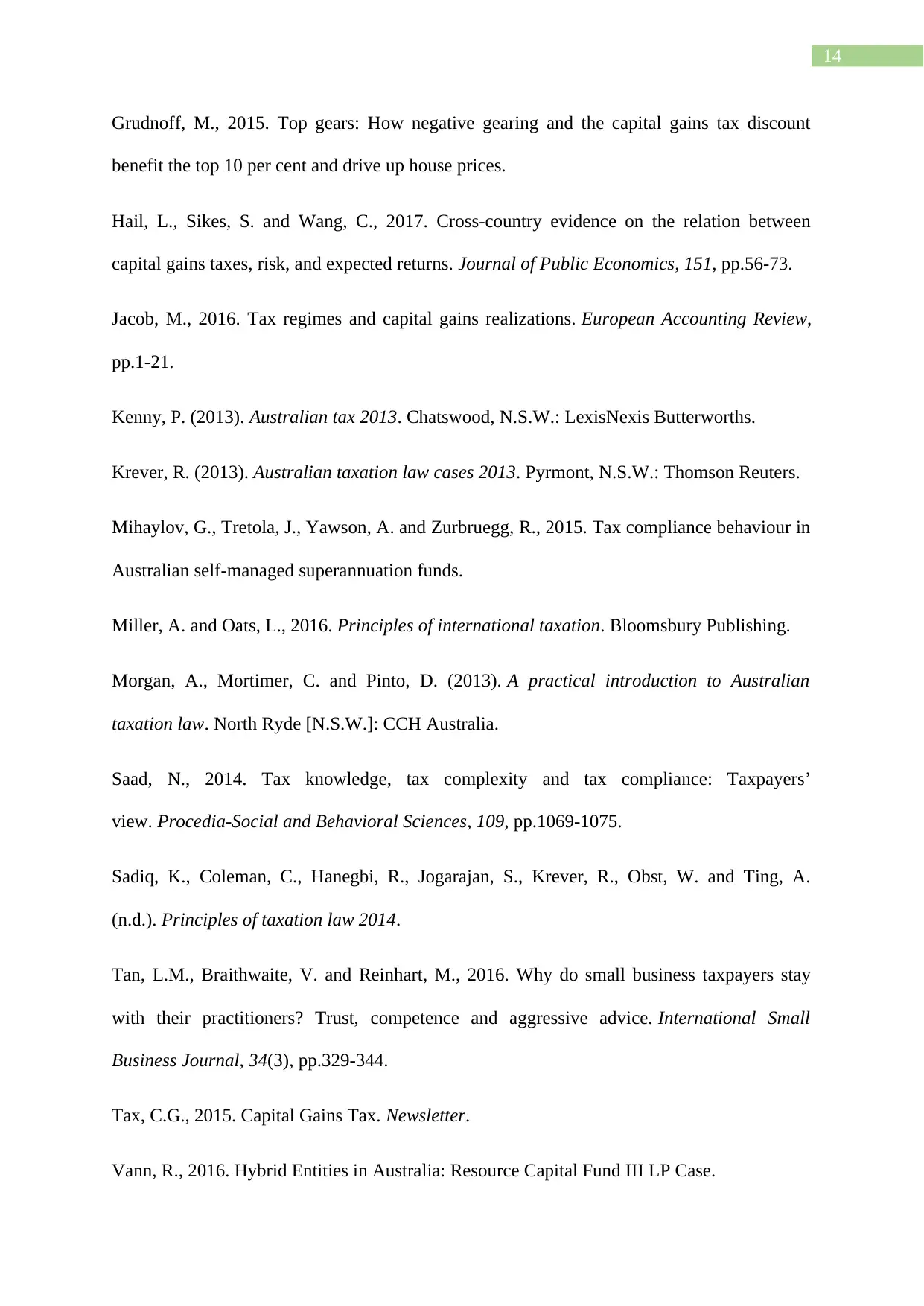
14
Grudnoff, M., 2015. Top gears: How negative gearing and the capital gains tax discount
benefit the top 10 per cent and drive up house prices.
Hail, L., Sikes, S. and Wang, C., 2017. Cross-country evidence on the relation between
capital gains taxes, risk, and expected returns. Journal of Public Economics, 151, pp.56-73.
Jacob, M., 2016. Tax regimes and capital gains realizations. European Accounting Review,
pp.1-21.
Kenny, P. (2013). Australian tax 2013. Chatswood, N.S.W.: LexisNexis Butterworths.
Krever, R. (2013). Australian taxation law cases 2013. Pyrmont, N.S.W.: Thomson Reuters.
Mihaylov, G., Tretola, J., Yawson, A. and Zurbruegg, R., 2015. Tax compliance behaviour in
Australian self-managed superannuation funds.
Miller, A. and Oats, L., 2016. Principles of international taxation. Bloomsbury Publishing.
Morgan, A., Mortimer, C. and Pinto, D. (2013). A practical introduction to Australian
taxation law. North Ryde [N.S.W.]: CCH Australia.
Saad, N., 2014. Tax knowledge, tax complexity and tax compliance: Taxpayers’
view. Procedia-Social and Behavioral Sciences, 109, pp.1069-1075.
Sadiq, K., Coleman, C., Hanegbi, R., Jogarajan, S., Krever, R., Obst, W. and Ting, A.
(n.d.). Principles of taxation law 2014.
Tan, L.M., Braithwaite, V. and Reinhart, M., 2016. Why do small business taxpayers stay
with their practitioners? Trust, competence and aggressive advice. International Small
Business Journal, 34(3), pp.329-344.
Tax, C.G., 2015. Capital Gains Tax. Newsletter.
Vann, R., 2016. Hybrid Entities in Australia: Resource Capital Fund III LP Case.
Grudnoff, M., 2015. Top gears: How negative gearing and the capital gains tax discount
benefit the top 10 per cent and drive up house prices.
Hail, L., Sikes, S. and Wang, C., 2017. Cross-country evidence on the relation between
capital gains taxes, risk, and expected returns. Journal of Public Economics, 151, pp.56-73.
Jacob, M., 2016. Tax regimes and capital gains realizations. European Accounting Review,
pp.1-21.
Kenny, P. (2013). Australian tax 2013. Chatswood, N.S.W.: LexisNexis Butterworths.
Krever, R. (2013). Australian taxation law cases 2013. Pyrmont, N.S.W.: Thomson Reuters.
Mihaylov, G., Tretola, J., Yawson, A. and Zurbruegg, R., 2015. Tax compliance behaviour in
Australian self-managed superannuation funds.
Miller, A. and Oats, L., 2016. Principles of international taxation. Bloomsbury Publishing.
Morgan, A., Mortimer, C. and Pinto, D. (2013). A practical introduction to Australian
taxation law. North Ryde [N.S.W.]: CCH Australia.
Saad, N., 2014. Tax knowledge, tax complexity and tax compliance: Taxpayers’
view. Procedia-Social and Behavioral Sciences, 109, pp.1069-1075.
Sadiq, K., Coleman, C., Hanegbi, R., Jogarajan, S., Krever, R., Obst, W. and Ting, A.
(n.d.). Principles of taxation law 2014.
Tan, L.M., Braithwaite, V. and Reinhart, M., 2016. Why do small business taxpayers stay
with their practitioners? Trust, competence and aggressive advice. International Small
Business Journal, 34(3), pp.329-344.
Tax, C.G., 2015. Capital Gains Tax. Newsletter.
Vann, R., 2016. Hybrid Entities in Australia: Resource Capital Fund III LP Case.
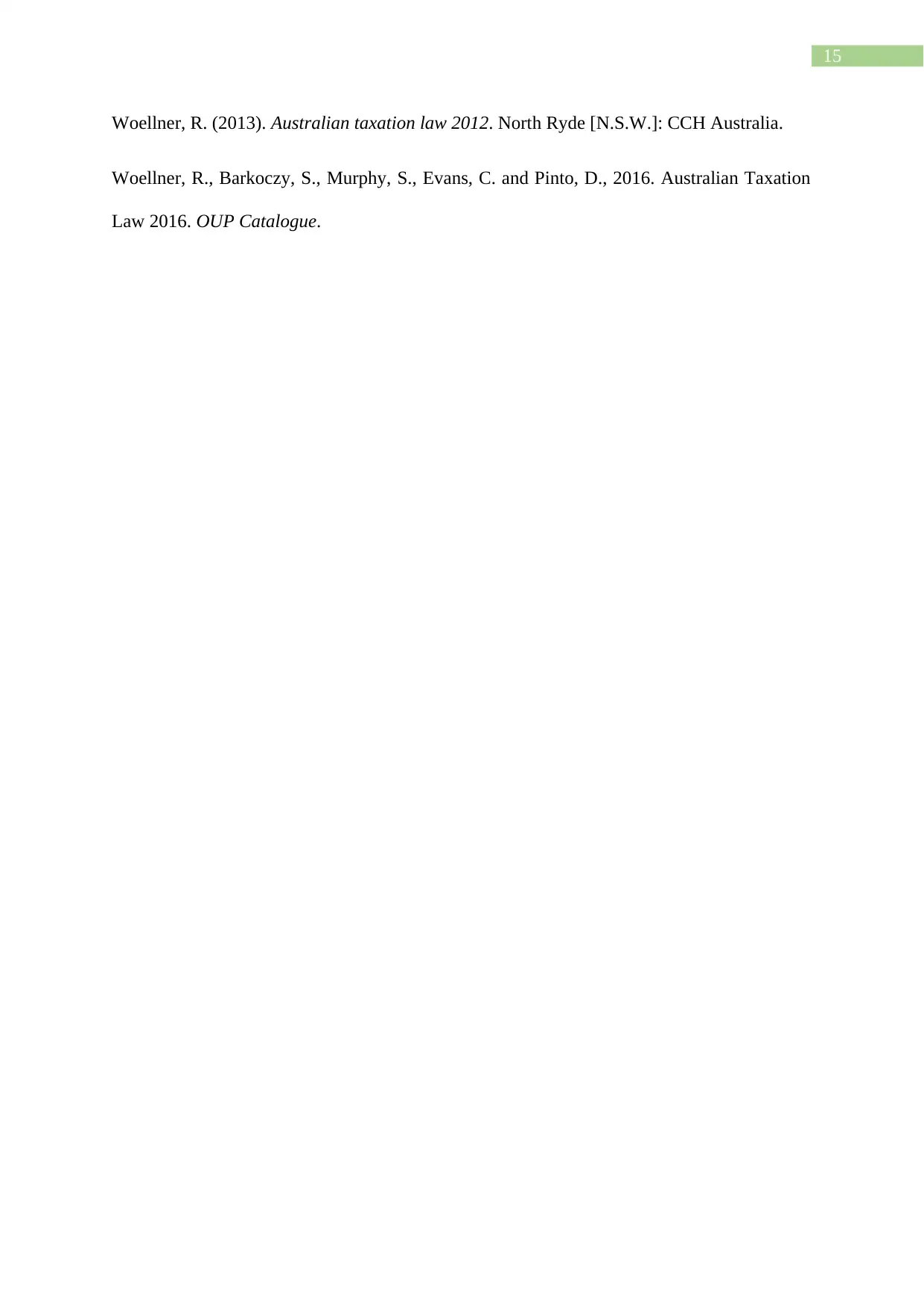
15
Woellner, R. (2013). Australian taxation law 2012. North Ryde [N.S.W.]: CCH Australia.
Woellner, R., Barkoczy, S., Murphy, S., Evans, C. and Pinto, D., 2016. Australian Taxation
Law 2016. OUP Catalogue.
Woellner, R. (2013). Australian taxation law 2012. North Ryde [N.S.W.]: CCH Australia.
Woellner, R., Barkoczy, S., Murphy, S., Evans, C. and Pinto, D., 2016. Australian Taxation
Law 2016. OUP Catalogue.
1 out of 16
Related Documents
Your All-in-One AI-Powered Toolkit for Academic Success.
+13062052269
info@desklib.com
Available 24*7 on WhatsApp / Email
![[object Object]](/_next/static/media/star-bottom.7253800d.svg)
Unlock your academic potential
© 2024 | Zucol Services PVT LTD | All rights reserved.




